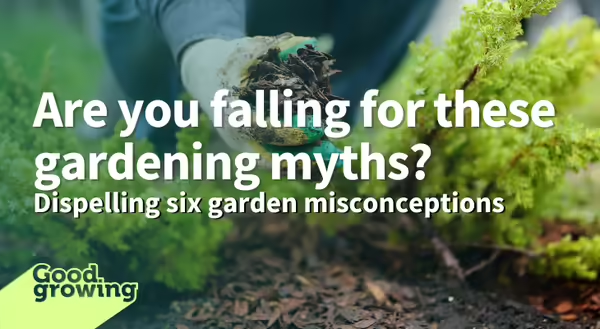
During my time as an Illinois Extension educator, I have run across many garden myths. Too many to keep track of. But some myths keep on coming up in teaching and talking with Illinoisians. Some myths are more localized, while others are widespread and often touted as garden “hacks” online.
Some garden myths have grains of truth, while others can be completely false. So, which myths are a bust? The following are some common and odd gardening myths I come across year after year.
Myth: If I treat my yard for white grubs this year, I won't have Japanese beetles next year.
Fact: An adult Japanese beetle can fly between 10-15 miles. When they find a suitable host plant for feeding, they release an aggregation pheromone that tells other Japanese beetles where to go for food and mating. So even if you wipe out the white grubs (which include Japanese beetle larvae) in your yard, they are more than equipped to travel from distant neighbors’ yards if you have tasty host plants.
More information about Japanese beetle control - Living with Japanese beetles
Myth: Adding sugar to the planting hole when planting tomatoes will result in the tomatoes harvested being sweeter.
Fact: The sweetness of a tomato is pre-determined by the variety of tomato you plant. Sugar can also stimulate bacterial growth in the soil. When bacterial growth is kicked into high gear, it can pull nitrogen from the soil, which prevents your tomato plant from getting the nitrogen it needs. A better use for sugar is cake or cookies.
More information about growing tomatoes - How to Grow Tomatoes
Myth: Ants are integral to helping peony flowers open.
Fact: That would be a neat trick, but the reality is also fascinating. Peony flower buds have small organs on the closed flowers called extrafloral nectaries. These nectaries secrete a sugary nectar that is attractive to ants. The nectary will feed the ants until the flower begins to open. This sounds like a good deal for the ants, but what does the peony get out of it? Ants will aggressively defend their food source, which in this case is the peony flower. Any other insect that comes along to take a bite out of the peony flower will have to contend with an army of defending ants.
More information on growing peonies - It's peony time!
Myth: Use salt in an asparagus patch to help control weeds.
Fact: This is somewhat true. Asparagus has deep roots and can tolerate or recover from salt damage better than shallow-rooted weeds. However, there is a reason salting your enemy's crops was a weapon of war for hundreds of years. Using salt in an asparagus patch can eventually cause excessive salt buildup in the soil, leading to both plant damage and soil structure damage. Fortunately, salt is soluble, and over time, rainfall and irrigation can leach the salt out of the soil, but the damage will already be done to your asparagus.
More information on growing asparagus - How to successfully grow asparagus in your garden
Myth: Apply turf fertilizer early in the spring to help encourage new growth.
Fact: Early spring turf fertilizer encourages top growth at the expense of root growth. That root growth is necessary for your turf to survive through the summer. A cool-season lawn already has a storage of energy for early spring growth. That's why we are mowing so often in the spring! If you plan to fertilize your lawn in the spring, it is recommended to wait until the vigorous spring growth begins to slow in early to mid-May. This will help your lawn recover from the flush of spring growth. Keep in mind that if you only fertilize your lawn once a year, a late summer to early fall feeding is the most important for recovery, as summer is very stressful for cool-season lawn grasses.
More information on spring lawn care - Spring Lawn Care
Myth: You should always amend the backfill when planting trees.
Fact: It is suggested to only add a minimal amount of amendments to the backfill in heavy clay soils. Otherwise, use the native soil to backfill the planting hole. Amending the soil can restrict outward root growth as it can be easier to grow in the amended soil, and the difference between the amended soil and the native existing soils can restrict water movement.
More information on planting trees - Plant A Tree
Myths abound in the gardening world. This is just a short list of some garden myths. If you are ever wondering about the best way to take care of your yard and garden, contact your local Illinois Extension office for help and information.
Good Growing Fact of the Week: Controlling grubs in your lawn won’t stop adult Japanese beetles or the nefarious mole! Moles will eat grubs, but earthworms are a staple of their diet.
Sign up for our emails! Want to get notified when new Good Growing posts are available? SIGN ME UP
Give us feedback! How helpful was this information (click one): Very helpful | Somewhat helpful | Not very helpful
MEET THE AUTHOR
Chris Enroth is a horticulture educator with University of Illinois Extension, serving Henderson, McDonough, Knox, and Warren counties since 2012. Chris provides horticulture programming with an emphasis on the home gardener, landscape maintenance personnel, and commercial landscapers. Additional responsibilities include coordinating local county Master Gardener and Master Naturalist volunteers - providing their training, continuing education, advanced training, seasonal events, and organizing community outreach programs for horticulture and conservation assistance/education. In his spare time, Chris enjoys the outdoors, lounging in the garden among the flowers (weeds to most).